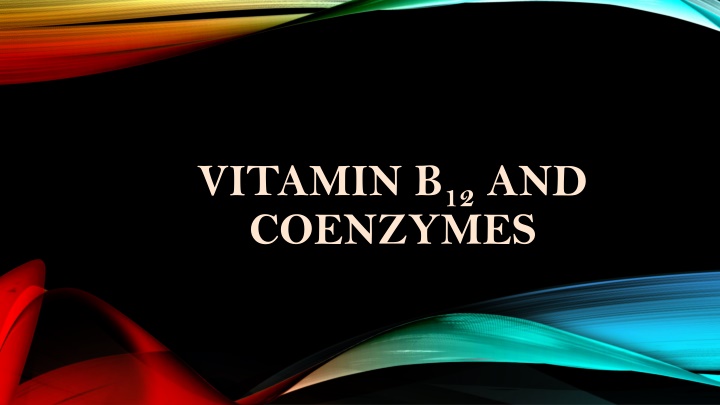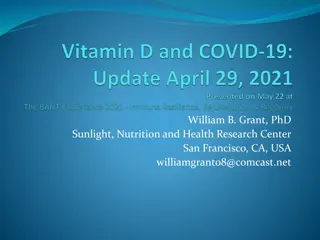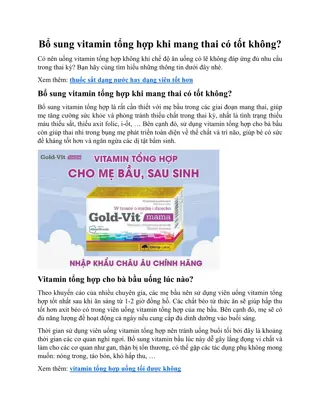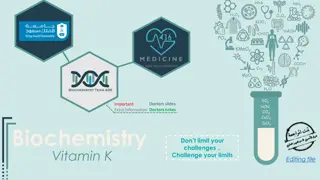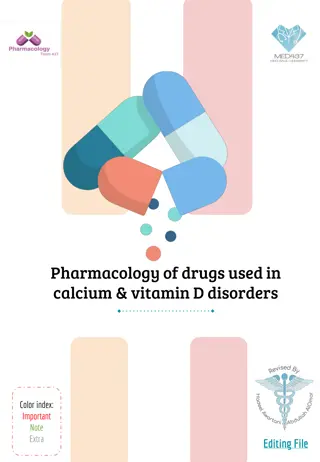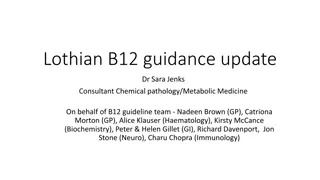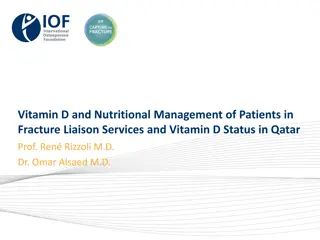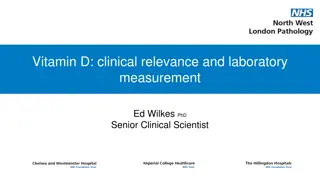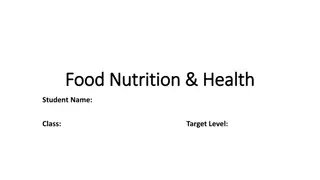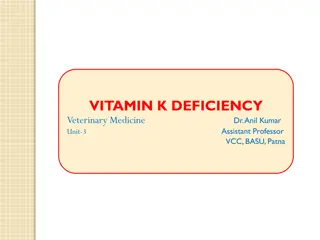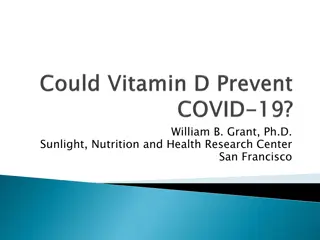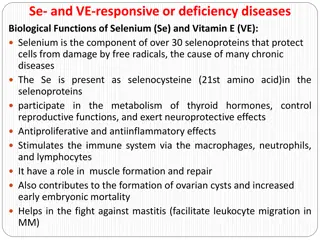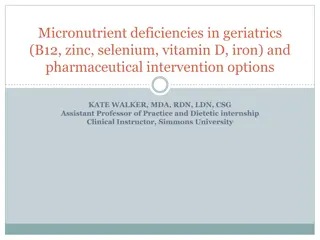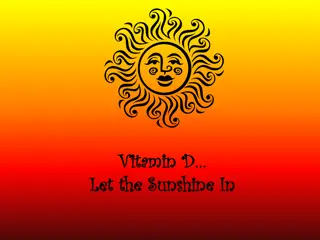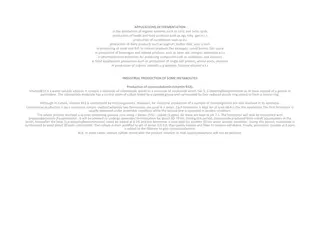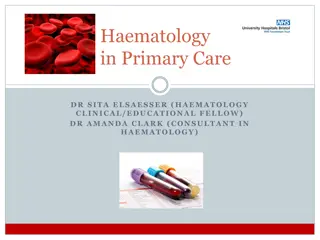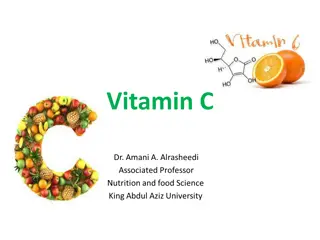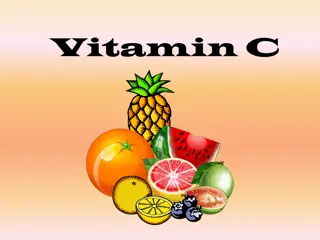The Story of Vitamin B12: Discoveries and Structures
Physicians discovered the importance of vitamin B12 in treating anemia by examining liver extracts. Dorothy Crowfoot Hodgkin's X-ray crystallography work revealed the complete structure of vitamin B12, earning her a Nobel prize. Vitamin B12 consists of a unique corrin ring with cobalt and various amide groups, vital for its function as a coenzyme in the body. Different forms like cyanocobalamin, hydroxycobalamin, and Adenosylcobalamin play crucial roles in metabolism. Understanding the structure and function of vitamin B12 is essential for maintaining overall health.
Download Presentation

Please find below an Image/Link to download the presentation.
The content on the website is provided AS IS for your information and personal use only. It may not be sold, licensed, or shared on other websites without obtaining consent from the author.If you encounter any issues during the download, it is possible that the publisher has removed the file from their server.
You are allowed to download the files provided on this website for personal or commercial use, subject to the condition that they are used lawfully. All files are the property of their respective owners.
The content on the website is provided AS IS for your information and personal use only. It may not be sold, licensed, or shared on other websites without obtaining consent from the author.
E N D
Presentation Transcript
VITAMIN B12AND COENZYMES
The story of vitamin B12 began when physicians recognized that anemia, a fatal disease caused by a low concentration of red blood cells, could be treated effectively by feeding the patient liver. This finding sparked a race to extract the compounds in liver and isolate the vitamin capable of treating anemia. Note: Vitamins are compounds that our bodies require for normal functioning and must be obtained from food.
The complete structure of vitamin B12 was successfully determined by Dorothy Crowfoot Hodgkin (Oxford University) using X-ray crystallography. She was awarded the Nobel prize in chemistry in 1964 for this work. She also solved the structures of other biologically important molecules insulin, penicillin and Cholesterol. She found that the structure of vitamin B12 is built upon a corrin ring system, which is similar to the porphyrin ring system present in chlorophyll.
CORRIN RING Structure is very close to porphyrin N N NH N It is also comprised of four heterocycles (rings containing a NH N N NH heteroatom, such as nitrogen) joined together in a macrocycle. Porphyrin Corrin Missing of one of the methylidyne linkage b/w two adjacent pyrroles. It has only one NH group.
VITAMIN B12 Water soluble, heat stable and red in colour N N It consists of corrin ring system Co It contain one cobalt atom connected to four N N nitrogen atoms The carbons at the periphery of the corrin ring are saturated The fifth valency of the cobalt is covalently linked N+ CH3 to a substituted benzimidazole ring. This is then called cobalamin. N H CH3 Note: Cobinamide, in which benzimidazole nucleotide is absent
VITAMIN B12 H2NOC CONH2 Corrin ring bear seven amide groups as H3 C CH3 H2NOC substituents. CONH2 H3 C H3 N N R C Three of these are acetamides, and three are Co H CH3 N N propionamides. CH3 One amide is N-substituted propionamide, H2NOC CH3 CH3 connected through the 2 carbon to an unusual CONH2 H N O ribonucleotide (ribonucleotide is the base unit, H3 C N+ CH3 O H O 5,6-dimethylbenzimidazole) N CH3 O- P O O O H O
VITAMIN B12 H2NOC CONH2 The sixth valency of the cobalt is satisfied by H3 C CH3 H2NOC the following groups (R). CONH2 H3 C H3 N N R C Cyanide (Cyanocobalamin) Co H CH3 N N H2O (aquacobalamin or B12a) Hydroxyl (Hydroxy cobalamin or vitamin B12b) CH3 H2NOC CH3 CH3 Adenosyl (Adenosyl cobalamin or Ado-B12 or CONH2 H N O B12 coenzyme) H3 C N+ CH3 O H O Methyl (Methyl cobalamin) Note: Ado-B12 and methyl B12 are the functional coenzymes in the body N CH3 O- P O O O H O
VITAMIN B12 The cobalt center in B12 can exist in +1,+2 and +3 state such as, B12a(CoIII) aquacobalamin B12b(CoIII) hydroxycobalamin B12r(CoII) B12s(CoI) There are two one-step electron reductions of B12 in biological system +e +e B12s (CoI) green B12r (CoII) brown, low spin B12a (CoIII) Red, low spin
VITAMIN B12 B12a, aquacobalamin, R=H2O, is reduced to B12rby Ascorbic acid, An electrochemical process, Catalytic hydrogenation,SnCl2, Thiols etc. B12a takes part in many reactions Loss of H+ to give hydroxocobalamin Displacement of 5, 6-dimethylbenzimidazole in strong acid by CN to give dicyanocobalamin B12r is reduced to B12s by NaBH4 or electrochemically B12r behaves like a free radical due to the odd electron in the dz2 orbital The dz2 elctrons in B12s behaves as lone pairs.
VITAMIN B12 The B12s is a powerful reducing agent and it can reduce O2 to H2O under biological conditions. It is also very good nucleophile and this property can be utilized to synthesize various types of cobalamins in vitro. These reactions are oxidative addition in nature. O B12s (CoI) RCOX R B12s (CoI) H3 C CH2N2 Co Co B12s (CoI) R RX Co
VITAMIN B12 Biomethylation MeCbl MeCbl FH4 Homocysteine Methionine N5-Methyl FH4 Cbl Cbl
VITAMIN B12 Methylmalonyl-CoA mutase activity of cobalamin It is also known as methylmalonyl isomerase, this vitamin B12 dependent enzyme catalyzes the isomerization of methylmalonyl-CoA to succinyl-CoA in humans. O O- O O- O CoA CoA S O S CH3 H succinyl-CoA methylmalonyl-CoA
